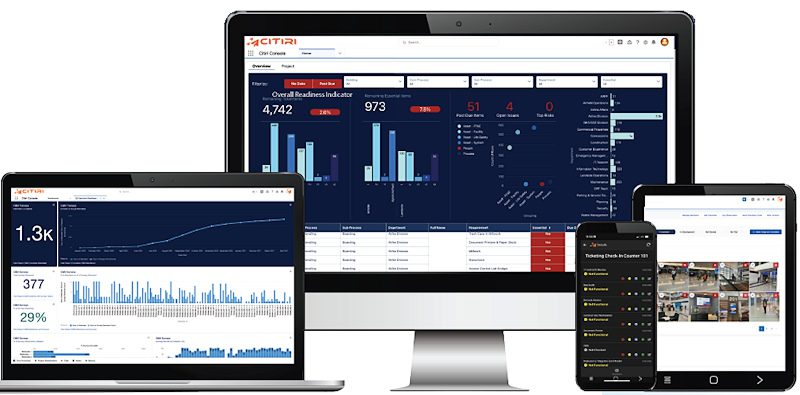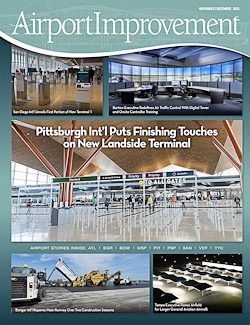“The reward of work well done is the opportunity to do more.”
This adage from Jonas Salk certainly applies to airport infrastructure improvements. As soon as crews finish building a new facility or system, you have to implement it into existing operations—another major undertaking.
That’s when some airports turn to an Operational Readiness, Activation and Transition (ORAT) specialist. Los Angeles International (LAX), however, largely handles such matters through an inhouse Airport Operational Readiness (AOR) Division, with limited support from outside consultants.
Tasked with handling ORAT for new facilities and ongoing projects, the AOR Division was formalized after successfully delivering key projects beginning in 2017, and has continued to demonstrate its benefit at the busy airport.
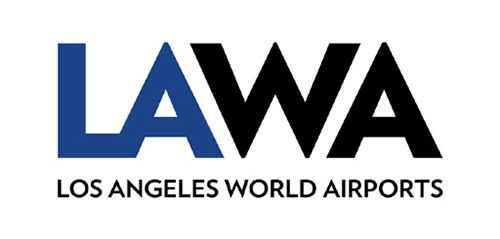 facts&figures facts&figures
Project: Developing Internal Operational Readiness Division Location: Los Angeles Int’l Airport Owner/Operator: Current Division Staff: 15 Current Active Projects: 10 Division Formed: 2017 Consulting Partners: Jacobs; M2P; Simpson & Simpson Scope Management Software: Citiri Key Strategies: Early involvement; collaborative team approach; stakeholder involvement; continuous support post-launch Key Goals: Successful introductions of new infrastructure; ensuring all facets are fully operational 1st day of service; cost-effectiveness; minimizing risks |
Lessons learned during construction of the Bradley West project set the stage for improving the overall delivery process. “In terms of project deliveries for LAX, it was challenging,” reflects AOR Manager Teresa Sarullo.
Mike Christensen, assistant general manager, Airports and chief airport development officer of Los Angeles World Airports (LAWA), concurs. “From my perspective, there were a number of projects that were not being delivered in a way that really allowed the easy transition from constructed project to operating facility,” he says.
Christensen explains that ORAT is a systematic, multi-disciplinary approach to support the successful introduction of new infrastructure and ensure that all facets are fully functional and ready for operation from the first day of service. When he introduced the concept to airport management in 2017, ORAT was still relatively new to the aviation industry in the U.S. At the time, it wasn’t well understood that implementation took organizational support, time, education, teamwork and patience.
“ORAT works on basic principles of establishing clear operational requirements at the onset of a project so that the expectations of the project sponsor are well communicated with the designers and the delivery agents,” Christensen explains.
To help demonstrate its benefits to LAWA’s Executive Committee, the AOR Division was introduced as a pilot program with consulting assistance from Jacobs. The first assignment for the new division was to support the $1.7 billion Midfield Satellite Concourse North, an extension of the Tom Bradley International Terminal. This project included the connecting of underground tunnels under taxiways, a feature that required extra planning and contingency options. Further complicating matters, the COVID-19 pandemic caused supply chain issues and delays that led to changes in the scope and timeline. Needless to say, introducing a new process to the team after the complex project had already kicked off was not an easy task.
“We had to jump in and develop an implementation plan for that project,” relates Melvin Price, ORAT National Practice Lead for Jacobs. “It was new for not just our team, but also for the people we were engaging.”
Sarullo notes that the project faced huge complexities and challenges, but they reaped benefits, including the development of standard operating procedures just for the tunnel itself regarding what to do in an emergency.

The AOR team’s ability to manage through unprecedented chaos and activate the new facilities was all the proof that LAWA executives needed to see the benefit of ORAT.
“It was successful enough that our CEO at the time made the decision to apply the ORAT process to every project that was in delivery,” Christensen notes.
Having the endorsement of the chief development officer who was delivering the project was a tremendous benefit for the newly formed division, Price adds, emphasizing the benefit of leadership buy-in. Opening Midfield Satellite Concourse North during the COVID pandemic was the team’s “launch point for success,” he relates.
From there, the AOR Division continued bringing more projects online, each with its own implementation processes, and some on concurrent timelines. From terminals to airport police stations and automated people movers to parking facilities, Price emphasizes that the ORAT process is integral to successful openings, regardless of the size or scope of a project.
“What we do in Airport Operational Readiness is go above and beyond,” Sarullo summarizes.
Enterprise Involvement
Leaders recruited employees with project delivery experience and subject matter experts from across the airport to form the internal ORAT team. “The idea was that this would be a LAWA-led division and we would have a representative from each of the top stakeholders,” Sarullo explains.
The size of the AOR Division has fluctuated over the years. Currently, there are 15 staff members working on about 10 projects throughout LAX. Specific roles that support various functional areas of readiness activation include:
- AOR lead;
- stakeholder manager;
- operations subject matter expert;
- facilities subject matter expert;
- IT and safety/security subject matter expert;
- Familiarization, induction and training manager;
- trials manager;
- mobilization and move subject matter expert;
- administrative manager; and
- scheduler.
As Sarullo describes it, team members act as advocates to ensure every stakeholder has a seat at the table. From concept to planning and design, through construction and post-construction, subject matter experts become critical participants in the successful deployment of an asset because they will ultimately receive the facility or system.
 “For project delivery teams, their sole purpose is to keep work moving on schedule and on budget. Integrating the needs of a stakeholder sometimes presents challenges,” Price explains. “That’s where we come in—to make sure they’re always fully represented as we go through each phase of a project.”
“For project delivery teams, their sole purpose is to keep work moving on schedule and on budget. Integrating the needs of a stakeholder sometimes presents challenges,” Price explains. “That’s where we come in—to make sure they’re always fully represented as we go through each phase of a project.”
Because it is an enterprise team, the AOR Division is able to work on multiple projects at the same time, build on the organization’s internal knowledge and provide consistent support and expertise. “We benefit from driving it internally, with expertise that is customized to our airport,” Christensen explains.
Having an in-house team can also allow better integration with other airport divisions and stakeholders. “Project delivery and operational readiness are two sides of the same coin,” Price says. “You have someone delivering the project, but then you need someone to help deliver that to the people.”
“Our focus is to make sure everything we do is getting the stakeholder operationally ready,” Sarullo adds. “That entails familiarizing them with a project from the beginning, getting their input for the design and making sure they understand how it’s going to work and be received for the current operation.”
The Process
According to Sarullo, the time invested in a typical project breaks down to roughly 25% for planning, 20% for design, 45% for construction and 10% for closeout. And while the cost varies, ORAT services usually account for about 0.6% of a project’s budget.
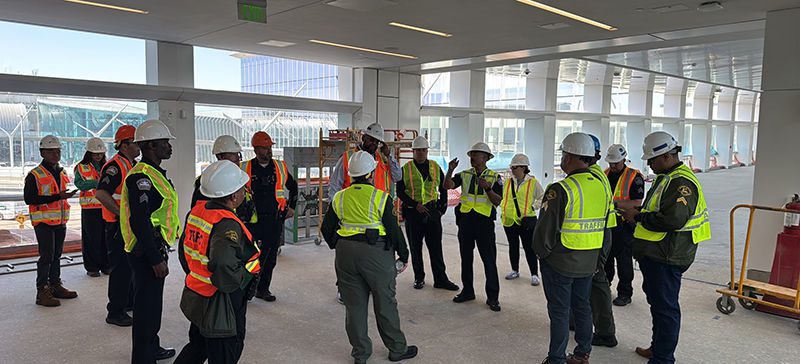
A familiarization walk of the automated people mover provided a strategic preview for airport police.
Price says the AOR team is guided by four principles: people, processes, systems and facilities—all the aspects that need to be accounted for to ensure a successful opening and beyond.
Sarullo explains that there are three essential AOR processes to enhance readiness and build stakeholder confidence:
- Concept of Operations—a high-level blueprint of the use of the system or project that outlines the intended operations, key stakeholders and their roles
- Familiarization, Induction and Training to provide sufficient and varied opportunities for stakeholders and end-users to become familiar with the facility, equipment, systems, processes and procedures.
- Operational trials that test and validate processes, systems, equipment and training in a simulated operational environment.
Standard phases include: initiation, planning, design, construction, transition and operations.
The AOR team’s responsibilities and processes include
- engaging stakeholders;
- coordinating and leading stakeholder working groups;
- executing familiarization, induction and training activities and trials;
- supporting project governance; and
- guiding readiness activities.
 “If we don’t have a good Day One operation, it colors the entire transition from construction into operation,” Christensen warns. At LAX, support from the internal ORAT division doesn’t end after Day One. The team stays plugged into a project for three to six months to assist and provide support if challenges arise.
“If we don’t have a good Day One operation, it colors the entire transition from construction into operation,” Christensen warns. At LAX, support from the internal ORAT division doesn’t end after Day One. The team stays plugged into a project for three to six months to assist and provide support if challenges arise.
Tracking and Transparency
While it may or may not sound like a simple process, ORAT relies heavily on detailed information tracking and collaboration among multiple departments. The AOR division that operates at LAX uses the Citiri software platform for storing and organizing all collected data. The system’s reporting functions help team members keep stakeholders informed.
 “It’s all about planning, preparing for the operations and minimizing the potential for disruptions,” explains Ortez Gude, chief executive officer of Citiri Inc. The software is designed to help project owners manage all operational components of a capital program and “de-risks projects by providing real-time operational data, reducing surprises and improving project execution.”
“It’s all about planning, preparing for the operations and minimizing the potential for disruptions,” explains Ortez Gude, chief executive officer of Citiri Inc. The software is designed to help project owners manage all operational components of a capital program and “de-risks projects by providing real-time operational data, reducing surprises and improving project execution.”
LAWA uses the software to manage trials, systems integration testing and operational testing. The system also helps the team track personnel through the training process, develop standard operating procedures and collect feedback.
“You need to manage the engagement and communications with all partners involved or influenced by a project, and our software manages, soup-to-nuts, all the things that you need to do from an operational standpoint,” Gude says.
Citiri includes a dedicated portal for stakeholders to access an incredible volume of real-time information about a given project. “LAWA really excels at stakeholder engagement,” Gude shares.
An executive dashboard allows Sarullo and her team to showcase all the efforts that support a given project. “Everything is very transparent,” she says. Tools, including a readiness assessment matrix, are important to communicating project status to leadership of various stakeholders.
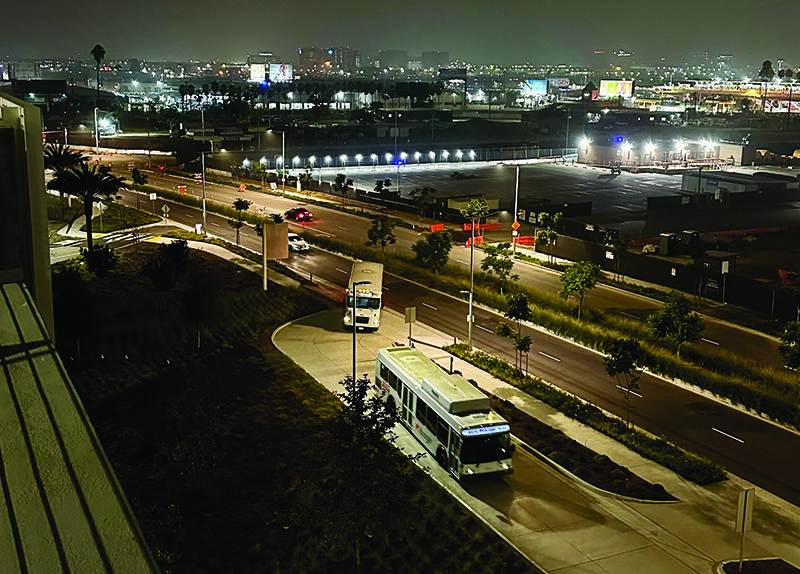
Smooth first-day operations require planning and testing ahead of time.
“In order for the executive team to make pivotal decisions, the operational readiness team needs to provide information in real time,” Gude emphasizes. “You don’t want to make decisions on something that’s out of date or incomplete.”
Full Project Partnership
Since its inception, the AOR team has evolved to become a true partner for the full lifecycle of a project. “We’ve come full circle from being a pilot program to a fully fledged division within LAWA working on the extension of the project where we got our start,” Price reflects.
Christensen says ORAT “really shines” on terminal projects, because they are among the most complicated building programs at an airport, with multiple moving parts and stakeholders. “It’s an extraordinarily complex piece of infrastructure, so [the AOR team] has the ability to better align in the beginning of the process, monitor through the process and ensure the complex network of stakeholders and systems are all in alignment and ready for Day One.”
“The benefit to LAWA is, as soon as the project is in planning, we start working with the Airport Development Group to align with and support them so we can be successful,” Sarullo says.
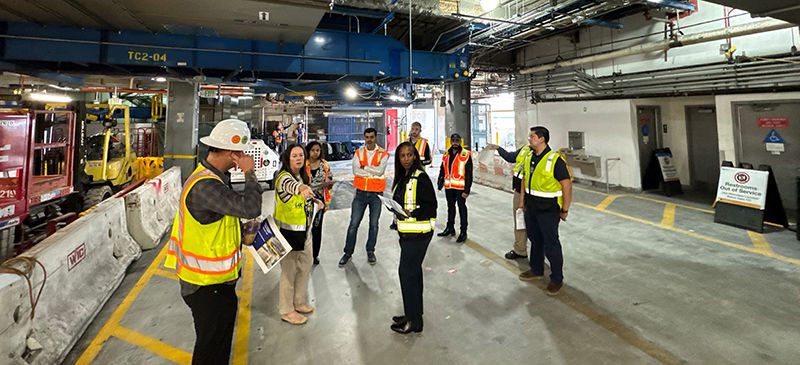
Tug trials are one of many operational tests the inhouse AOR team conducts.
Originally, ORAT responsibilities were nested within the Development Group, but they were transitioned to Operations around 2021, which Christensen says works better at LAWA. “Developing and delivering complex infrastructure in an airport environment is very challenging,” he relates. “The Operations Group is totally focused on successful operations once a facility is delivered, so there was more alignment once we made that change.”
Staffing for an ORAT team needs to be carefully chosen, advises Christensen. “This group has to be extraordinarily collaborative and communicative because it’s touching bases with so many different stakeholders,” he explains. Flexibility and adaptability in responding to project challenges and changes are also critical.
Evolution of AOR
After seven years and roughly 12 successful project activations, Sarullo says the AOR Division of LAWA has proven that ORAT methodology can help minimize risks and operational disruptions while enhancing the overall airport experience when opening or expanding facilities. It aligns stakeholders with the testing of processes, facilities and systems to optimize for smooth operations on Day One and beyond, she adds.
Sarullo and her team have continued to develop and refine ORAT processes to provide the best possible support for airport projects. They also developed and regularly update an AOR Procedures Manual that acts as a blueprint to inform all airport partners of the purpose and value of their respective divisions.
“Every single day, it’s about improvement and bringing value to the airport, engaging with everybody,” Sarullo explains.
With the variety and ongoing volume of projects at LAX, no day is typical for the AOR team. “There’s always so much excitement,” she remarks. “There are challenges, but every single day we ask, ‘How do we improve for our team, and how do we improve for our stakeholders.’”
According to Price, strong and steady support from airport leadership has helped foster success for the AOR Division. Early program involvement, a collaborative team and continuous post-launch support ensures cost-effectiveness and customized expertise systemwide, he adds.
“LAWA’s approach to operational readiness, including stakeholder engagement and transparency, is a best practice for other airports to emulate,” Gude concludes.

